
Over six articles we're publishing a detailed outlook from ANZ NZ's economics team on six key themes for 2015.
Here is the third one. (Links to the previous themes are at the bottom of this page.)
By Cameron Bagrie*
The upshot: Growth may have peaked but the trend still looks favourable.
Key reasons for optimism that solid growth lies ahead include better productivity performance, rising capital intensity, unlocking growth from areas of advantage (including an abundance of natural resources), growing signs of a more tech-savvy economy, a well-functioning political system where leadership is dominating populism, greater signs of execution on opportunities across the tradable sector, a complacency virus at bay, and a sound microeconomic reform agenda.
Challenges in the form of an easing impulse from migration and demographics are undeniable, and falling dairy prices will cause challenges, but New Zealand’s terms of trade are still elevated.
While there are the usual cyclical risks to manage across the economy, it is prospects for the trend rate of growth that is key to raising living standards and investment decisions.
Sustained lifts in performance over time quickly accumulate.
We’re constructive over where we see trend growth.
We can point to the conventional breakdown of drivers:
• Productivity growth has improved, consistent with the feedback we have been getting on the ground.
You don’t have to wander too far around any manufacturing firm or farm to get a real-time handle on this.
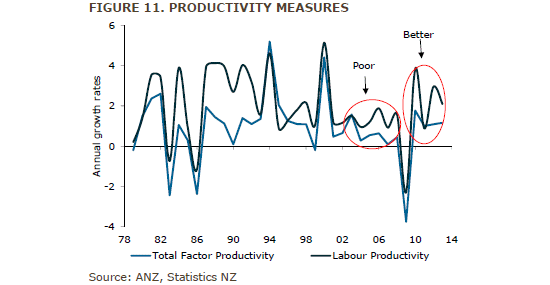
• The pick-up in labour productivity of late is likely to be linked to increasing capital intensity, with growth in the measured capital stock averaging 2.8% pa since 1990 and nearly 3.5% pa since the mid-1990s, consistent with the upward trend evident in investment as a share of GDP.
While investment is a cyclical component and a major swing variable, there has been an upward trend evident in business investment as a share of GDP since the early 1990s, which has boosted the productive capital stock. The capital stock is also evolving. Close to three quarters of the capital stock is privately owned, up from two thirds in the late 1980s.
While the bulk of the capital stock is in the form of buildings, the increasing importance of other investment is emerging. Strong investment has contributed to a trebling of the stock of plant and machinery since the 1980s, with the increasing emergence of other components (eg. computer software).
Given technological change, this trend is not unique to New Zealand, with surveyed business intentions suggesting further upside potential, although investment spending is still vulnerable to an adverse shock, both here and abroad.
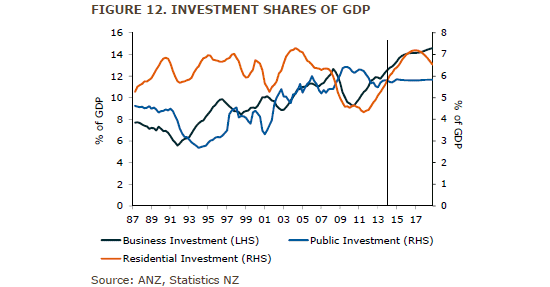
• Prospects are for the terms of trade to remain elevated.
It is certainly true that we are seeing a cyclical correction in the terms of trade, but they are still nearly 30% above long-run averages. Trends still look favourable. We could get technical and go through the positive broad protein demand story globally. Or we can take a shortcut and characterise future terms of trade movements by simply comparing baskets of goods against one another.
The question is simple; which good is likely to get relatively cheaper over the coming decade?
A pound of butter versus any piece of IT equipment? A kilogram of steak versus a new car? A few fillets of fish versus articles of clothing? New Zealand exports one group and imports the other. We’ll bet on the former products over the latter any time, which implicitly leaves us optimistic on medium-term trends in New Zealand’s terms of trade and purchasing power.
• The production possibility frontier is being pushed out by utilisation of the natural resource base.
Recall that back in 2010, the World Bank ranked New Zealand 8th in the world in terms of our natural resource stakes per capita (and Australia a few notches below). We also had the highest holdings of renewable natural capital per person.
There are numerous examples of increasing utilisation of our resource endowment – oil exploration (though this may go on hold given the present level of global oil prices!), new irrigation schemes, mining ventures, and the like.
In the irrigation space there are plans in place to double the total irrigable land in New Zealand to 1.38 million hectares, which would equate to 12% of total agricultural land. This would be a tremendous boost to productivity, as irrigated farmland generates three times the production of non-irrigated land.
New avenues will undoubtedly appear, although there is a balance to be struck between utilising our resource base and safeguarding the environment for future generations.
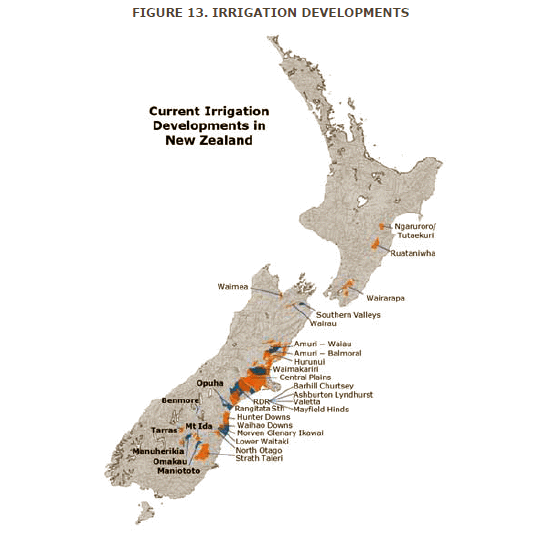
• We’re picking the migration inflow to remain strong and above “average”.
Our reasoning is simple. Migration doesn’t drive the economic cycle, it moves in response to it, giving it greater “swing” and variability. Or put another way, when things are good (bad), migration adds (detracts) further from the growth picture. But it all starts with the growth foundations, and while we can see some economic challenges over the year ahead in terms of the cycle, they look far more manageable than offshore peers.
• While demographic challenges are real there are also reasons for optimism regarding the supply of labour, despite the unemployment rate being in the low 5’s.
Courtesy of strengthening net PLT immigration (much of which is due to New Zealanders returning overseas), annual growth in the working age population is approaching 2% per annum, the highest in a decade. Despite more baby-boomers hitting retirement age, labour force participation is the third-highest on record, boosted by reforms to get more people in the workplace, balance sheet considerations, a healthier older-age workforce and technological change.
Labour force participation for the over 55s has doubled over the last 20 years, while falls in unemployment rates for younger workers bode well for future productivity levels.
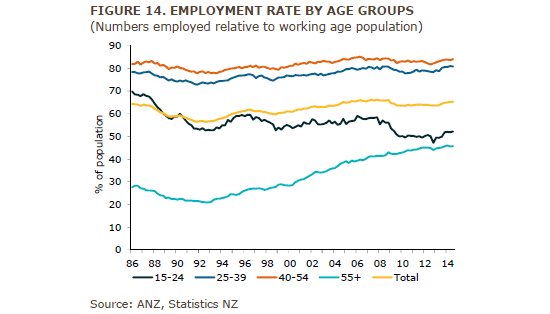
• There are emerging signs of a more tech savvy and innovative economy.
As we discussed in Theme 1, the world is going through a period of profound technological and social change. New Zealand is no different.
We have one of the highest rates of internet usage in the world, with the Government funding a program to increase the use of ultra-fast broadband. It holds out the prospect of boosting export earnings and increasing employment; just look at the number of IT start-up firms in New Zealand, the number of business hubs forming (which brings together ideas, business acumen and capita funding) and the considerable potential of New Zealand software firms (eg. Xero).
Smartphones, iPads and other wireless devices are a part of everyday life for ordinary New Zealanders and have helped lower search costs and increased the amount of information available to New Zealand households, businesses and Government.
The productivity enhancing impact of this new technology is hard to measure, but the anecdotes we are hearing are positive.
The adoption of best-process techniques from overseas is generating tangible benefits here, but we are still at the cutting edge of development locally. Think how successful Weta Workshop has been, look at America’s Cup technology (although it did not deliver the ultimate result we all hoped for), and see the agricultural innovation commonly displayed at Fieldays.
We’ve kept our analysis of the conventional factors brief because we believe there is also a huge array of unappreciated dynamics at work.
They reflect a more subjective reading of the tea leaves and anecdotal evidence.
The latter may appear a bit woolly, but frankly the New Zealand economy is the accumulation of the decisions of 4.5 million people.
By the time their collective actions appear in the hard data-flow the horse has bolted. Economists need to keep up to play on subtle shifts in behaviour. They add to the macro-vibe.
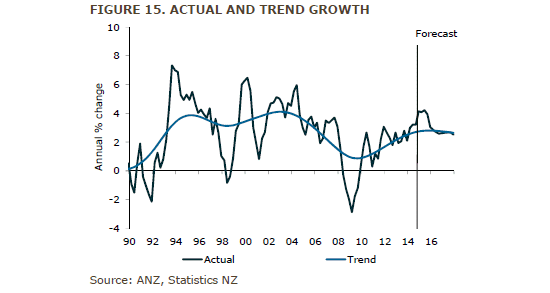
THE MICRO AGENDA IS ROBUST
Microeconomic issues are often overlooked when assessing the macro-economy, but the economy is the summation of its parts. Economists can point to heaps of factors that influence growth, though the problem with some, such as investment and labour supply, is that they are growth!
It’s all pretty basic and starts with getting the right incentives in place; this drives the right behaviours. It’s not just policymaker 101, but management 101; a poor set of KPI’s (key performance indicators) for a staff member will drive sub-optimal behaviours.
New Zealand has already done a lot of the heavy lifting in terms of getting a system that is world class at the macro level. We rank at the upper end of the OECD in terms of literacy, attainment of secondary and tertiary education (though there are real issues over gaps between the top and bottom students), transparency of our institutions, and law and order.
Access to childcare has vastly improved, more than half of the population has now enrolled in KiwiSaver, and reforms to the RMA will help address infrastructure bottlenecks.
In the 2014 and 2015 World Bank Group surveys, New Zealand ranked second in terms of the ease in doing business out of 189 economies. However, we’ve got some clear challenges in key socio-economic groupings too.
The past few years, and the outlook for the next few, are notable for the vast array of initiatives being pursued.
Here are just a few examples.
• Tax rates.
Continue to move these lower where possible.
• KiwiSaver.
It is now ingrained in the national psyche. Capital markets are deeper courtesy of SOE sell-downs. The regulatory framework has been tightened.
• The Super or “Cullen” Fund.
Stellar returns. Some clever investment in New Zealand assets. Resumed contributions can’t come soon enough.
• The labour market.
The 90-day trial period and the introduction of probation period will enhance labour market flexibility and boost prospective employment as they offer employers the option to “try before they buy”.
• ACC.
Levies have gone down – a lot (it’s equivalent to a sizeable tax cut), and there are more falls to come. That’s telling us something about the management of the “tail” and liability.
• Education.
Investment in early childhood education has been ramping up for a decade. A year ago the Government announced it would invest an extra $359 mln in funding over the following four years to help raise student achievement.
An investment approach is being taken to improving teaching practices by enabling the most effective teachers to share their expertise across multiple schools. More funding is going to the sciences over the arts.
• Transport.
The previous Government inherited a decade of under-investment in key infrastructure and moved to address it. In recent years the current Government has moved to an outcomefocused investment approach based on a “one network” framework to apportion transport investment according to where it will do the most economic good to the nation, rather than what might be considered “fair” for each region – or where it will buy the most votes. The roads of national significance programme (a key part of the larger National Infrastructure Plan) is one of New Zealand’s biggest ever infrastructure investments.
• Social welfare.
Extensive reform such as requiring solo mothers to seek part or full-time work has had the side effect of raising labour force participation. There is more targeted intervention to make sure at-risk kids don’t fall through the cracks (i.e. the 2000 at-risk kids mentioned in the 2014 Budget).
The CEO of the Ministry of Social Development has a KPI to reduce welfare as opposed to manage it. That’s small but signals an intent to drive different behaviours.
• Housing.
Multi-faceted solutions that encompass both demand and supply side aspects are being pursued to tackle a complex housing shortage and affordability problem.
• Water.
The national bottom lines and revised policy for freshwater are busy being debated and implemented by regional councils up and down the country. The collective aim of policy changes is to safeguard freshwater as a key natural resource.
The dairy sector has implemented the Sustainable Water Accord which is more comprehensive than its predecessor, encompasses all the major dairy processors, and commits the sector to helping address its impact on freshwater.
These initiatives suggest there is more commonality and progression between industry and regulators on this tough issue than most realise.
• Biosecurity.
The Ministry for Primary Industries is introducing Government Industry Agreements to create structures under which the Government and a sector can work together to identify high-priority biosecurity risks; make consensus decisions on how to respond to threats; and share the cost of responses. This ensures there is a robust system in place, which is necessary given the increase in trade and several costly incursions.
• R&D.
There is more streamlining of the Research and Development pipeline between government and the business sector. This has included a revamp of Crown Research Institute funding and objectives to better deliver national priorities and respond to the needs of research users, particularly business. The creation of a one-stop government department (Ministry of Science and Innovation) to better integrate policy, strategy and funding, ensuring stakeholders deal with a simpler system that provides more consistency and certainty. We’d still like to see the tax system used more directly though.
• The financial system.
It has been strengthened post-GFC. Liquidity policy changes have required banks to lengthen the term of their liabilities, obtain funds from more stable sources (such as term deposits rather than international money markets), and increase the value of liquid assets held on their balance sheets.
The Government has also dramatically lengthened the duration of its debt portfolio, and sourced funds from new markets such as the inflation-linked bond market.
More recently, macroprudential policy has sought to reduce the systemic risk of a fall in housing collateral values by restricting the volume of high-LVR loans banks have been able to write. The RBNZ has also implemented a review of capital adequacy, which will likely include benchmarking and closer scrutiny of banks’ internal capital models and more in-depth stress testing.
That’s just a sample of what has been going on. It’s impossible to quantify their impact but we’re talking about collective mass and grunt across a wide spectrum.
Not only are initiatives aimed at smoothing tension points or speed bumps (i.e. housing in Auckland); they are about building collective economic muscle and the resilience of the economy.
It’s far from pristine (there are gaps in the local authority level; Auckland’s housing woes are immense; you can’t duck from climate change and retirement age challenges forever; we’d make KiwiSaver fully compulsory; we’d like to see more in some areas such as R&D etc) but it all adds to the vibe.
New Zealand is an economy that is far from standing still.
Better micro settings are the precursor to better macro performance and New Zealand looks to have made some considerable deposits (and continues to do so) in that growth jar.
Little things can become big; think about the pending boom to Queenstown from changes to the curfew on night flights.
THE TRADABLE SECTOR APPEARS TO BE WALKING THE WALK IN REGARD TO OPPORTUNITIES ACROSS ASIA
There have been some own goals (such as food safety scares) but examples of genuine point-scoring are numerous.
• Further progress in the free trade (FTA) arena, with the announcement of the Korean FTA late last year.
Bilateral agreements seem all the rage at the moment. With everyone jumping on the bandwagon this potentially dilutes their future potency, but equally you can’t afford to be left out, or competitors can get a big leg up. New Zealand’s bilateral agreements now cover nearly 21% of the globe’s population and 42% of GDP. Under negotiation is access to a further 29% of the global population and 30% of GDP. The Trans Pacific Partnership (TPP) remains a mustwatch in 2015, with an opportunity to gain better access to the wealthy US and Japanese marketplaces.
• The dairy sector has stepped up its investment and the building of partnerships to process more of the milk it collects into branded consumer products.
If well executed over coming years this will deliver higher and more stable returns to shareholders. Over the last 12-18 months Fonterra has restructured a number of its businesses, re-focused its joint ventures, announced new joint ventures targeted at growing its consumer branded and foodservice products, created more product manufacturing flexibility, and undertaken other new investment to speed up the implementation of its “value-add” strategy. Just about all the other independent dairy companies have undertaken similar investment, mostly into infant formula and nutritional dairy product manufacturing capability.
• The dairy sector and farm leaders are showing more corporate responsibility on issues from the affordability of dairy products for New Zealand consumers, through to environmental issues.
This is helping to improve the public's perception of the industry and keeps heavy-handed regulation at bay. It also helps in-market positioning and marketing for branded consumer dairy products. Often there might not be too much of a premium directly associated with some of the initiatives, but what it does do is open the door and give New Zealand product preferred supplier status.
• The Red Meat sector is on the improve with solid bottom-lines expected in 2014/15 and meat processors have returned to profitability again after the 2012 disaster – albeit margins remain very slender.
Structural issues still exist, but there are signs the sector is now moving to address these. The Red Meat Profit Partnership is the first material step-up in investment in a long time, aimed at addressing the performance gap between farmers within the sector. It’s a collaborative program worth $64.3 million over seven years and brings together nine industry partners and the Government, who are coordinating their efforts to increase profitability and productivity in the red meat sector. Initiatives from this investment are just starting to flow. Beyond the farm-gate, meat processors are continuing to invest and reconfigure their businesses. There are ongoing discussions on different approaches to address processing overcapacity (i.e. moratorium on new processing capacity) and some merger and acquisition activity taking place.
• Primary growth partnership now boasts 18 projects with $680 million of government and industry funding committed for the lifetime of the projects.
Two of the programs have been completed so far and two commercial developments have taken place as a result. In reality most of the economic benefits are longterm, but the successes so far are encouraging. Two commercial developments have been released so far. The first is the FarmIQ System, an online IT farm information hub system that connects farmers more directly with their processor and consumers, as well as helping them to drive farm performance. The second is N-Guru™, which was developed through the Clearview Innovations program, a software tool developed with AgResearch that enables farmers to tailor nitrogen application rates to areas that are likely to produce the highest pasture response. There are many other new innovations that are likely to emerge in the medium-term.
• There have been 17 partnerships launched between Chinese and New Zealand companies following the Chinese Premier visit towards the end of last year.
For New Zealand it isn’t just about establishing trade and business relationships. In order to make the most of the opportunities on offer in China and throughout Asia there is another leg – deepening of economic and financial ties – that needs to take place. This involves the exchange of skills (migration), services, technology and capital (foreign direct investment). Trade with China represents 20% of our bilateral merchandise trade flow, but only 2% of our overall foreign investment flow. At the current juncture there is no doubt significant progress has been made on bolstering migration and trade links with many countries, but deepening financial and other ties seems to be in the early adoption stage. The memorandum that was signed in late year may help to get the ball rolling.
• The kiwifruit sector is recovering strongly from the 2010 Psa outbreak.
It’s a remarkable story for a sector that looked out for the count just a few years ago. The new Gold3 cultivar grafted extensively in the winter of 2012 has proved more tolerant to Psa than researchers anticipated when it was first selected to replace the ravaged Hort16a variety. Growers have also adapted management practices, as well as learning to manage the new variety and control the disease. There are some areas where Psa continues to affect the new cultivar significantly, particularly in low-lying, damp areas and higheraltitude, elevated sites, but at this stage the sector looks on track for a full recovery of volumes in 2016/17.
• Innovative marketing programmes through non-traditional channels.
One example is Zespri’s foray into China’s social media network, which has exceeded all expectations. The company staged a massive water fight in Shanghai to mark the launch of its Sungold kiwifruit, with more than 1,000 people taking part and a video of the event received more than 25 million hits on Chinese social networking sites. With China having one third of the world’s social network users, being able to tap into this channel is phenomenal.
• More innovation, investment and structural change across a range of smaller primary sectors that all have big growth aspirations over the next 10 years.
There are many examples from the last 12 or so months centred around apiculture, aquaculture, goat milking, sheep milking, a range of small horticulture sectors and the wool industry. Manuka honey is one example, with growth aspirations to become a $1.2 billion earner by 2028 (presently $75 million). There are discussions and investment underway to try and unify certification standards, form a single apicultural industry body, and build industry capability. Active manuka honey has scientifically proven, health-giving properties, which is driving global demand across a range of channels from food, beverages, nutraceuticals and health & beauty care. The activity in manuka honey is unique to New Zealand, which creates a highly defensible barrier to competition. Along with its economic potential it can also be used to achieve environmental rejuvenation on erosion-prone land and riparian planting. There are still plenty of challenges, such as counterfeiting, but some of initiatives being undertaken look to be steering the sector in the right direction.
• Despite the elevated NZD, prospects for the tourism sector are bright, with the September 2014 MBIE tourism sector outlook pointing to a 30% increase in visitor numbers through to 2020, with overseas visitor spending up by a quarter.
More active promotion and increasing connectivity is seeing New Zealand gain market share in the international tourism market, with the forthcoming Cricket World Cup and FIFA Under 20 Football World Cup expected to provide a 2015 boost to visitor numbers.
WE’RE SEEING MORE LEADERSHIP THAN POPULISM
It has been said that democracy is the absolute worst form of governance apart from all the others. It is a fact that when times get tough, voters are tempted to vote for politicians promising populist short-cuts that are seldom good for growth.
In New Zealand, while we’d certainly like to lead some sacred cows to the slaughter-yard (universal super, never lifting the retirement age, ruling out a capital gains tax, interestfree student loans), on the whole the Government has the confidence to pursue policies that are economically sensible if not vote-winning (free trade, asset sales).
But more importantly, we are seeing a lot of unity in the political spectrum in some major areas. Witness the pre-2014 election pitching from all the major parties about running surpluses and keeping debt low. That sort of unity is unusual but telling us something about how the politicians (who poll extensively) are reading the mood of the nation.
Moreover, opposition political parties are prepared to put some politically difficult policies on the table and we’ll give any party credit for that.
This sort of dynamic is even more important when we eye growing political fragmentation globally.
SOCIETY APPEARS RECEPTIVE TO CHANGE
An economy is a super-tanker: it takes time to turn. Leadership can only take you so far – habits have to change on the ground.
Some habits – such as New Zealand’s fixation with housing – need modification.
Housing is not a productive asset, and the proportion of wealth that New Zealanders devote to it (around 85% here, versus 82% in Australia and 72% in the United States) sucks up capital that could otherwise be used to start and grow companies. Our economic performance after all, reflects the collective decisions of 4½ million individuals, whether that’s their borrowing, spending, or voting decisions.
Japan’s lost decade epitomises a refusal to bite the bullet. Europe is witnessing the same.
Despite signs of pre-2008 style behaviour emerging in some areas (Auckland housing), it appears that the critical mass in New Zealand remains tilted towards necessary structural change. Witness the continued uptake of KiwiSaver despite the smaller carrot now on offer; the focus on fiscal responsibility in the 2011 and 2014 elections; a refreshingly non-hysterical – if ultimately stalled – discussion of the possibility of raising the retirement age beyond the age of 65; and the saving debate turning more towards compulsion.
The fact that life is tough for retailers is encouraging sign for the broader economy; despite being well into an economic expansion people are being responsible with their cash and the household saving rate is firmly in positive territory.
Such signals don’t guarantee that society is willing to do the hard yards, but it’s reassuring that things are moving in the right direction.
However, we’re also seeing evidence of old-style behaviour in the apparent belief that Auckland house prices only ever go up, though signs of this flowing through into the broader economy are muted.
THE COMPLACENCY VIRUS APPEARS AT BAY FOR NOW
Economies tend to go through a four-stage process, we characterise as the CROC.
It starts with a Crisis necessitating a Response (aggressive monetary policy stimulus, currency realignment, fiscal stimulus and firms getting back to basics to drive productivity etc).
You then gravitate into Opportunity as a recovery broadens into an expansion. We are currently well into this stage.
The final stage, the one that kills the expansion, is Complacency.
Real wages outstretch productivity, cost structures become bloated and competitiveness wanes, structural imbalances form (eg. excessive debt), and populism starts to trump leadership on the political front. The seeds are sown for the next Crisis, and the spiral is in motion.
The complacency virus so far seems at bay.
Outside some giddiness in housing, we’re not seeing early warning indications of a deterioration in structural metrics – which is something that can’t be said of much of the rest of the developed world since the Global Financial Crisis.
The collective economy appears focused. Indeed, it was notable that policymakers and the incumbent Government hosed down talk of the “rock-star economy” in 2014; they are well attuned to the risk of complacency setting in. The theme seems to be more “rock solid”.
CONCLUSION
At this stage of the economic cycle New Zealand would typically be facing problems of rampant inflation and a blow-out in the external accounts.
It is very encouraging for our future growth prospects that that is not the case.
In addition, growth in the quantity and quality of labour and capital, and improvements in how we use them, bode well.
That is not to say that the economy is bullet-proof – as a small open economy we will always be buffeted by global forces, and some worrying signs remain in the Auckland housing market. However, there is mounting evidence that the potential trend growth rate in the economy has lifted, and that’s what really matters for standards of living over the long haul.
While there are obvious risks and challenges to be mindful of, and the business cycle has not gone away, New Zealand remains well placed and we suspect is in the amidst of a super-cycle where success breeds even more success.
Get the right ingredients for growth in place and an economy can quickly be engulfed in a positive spiral where solid growth and good credentials encourages greater investment and belief in the medium-term story.
-----------------------------------------------------------------------------------
*This report was written by the ANZ New Zealand economics team which consists of chief economist Cameron Bagrie, senior rates strategist David Croy, senior economists Sharon Zollner and Mark Smith, economist Peter Gardiner, senior FX strategist Sam Tuck, and rural economist Con Williams. It is used with permission.
A link to Theme 1 - Change is the new normal, is here.
A link to Theme 2 - Localised focal points, is here.
A link to Theme 3 - The trend is your friend, is here.
A link to Theme 4 - Our key downside risk, is here.
A link to Theme 5 - Liquidity vs fundamentals, is here.
A link to Theme 6 - Addressing income inequality, is here.
8 Comments
4 mln Kiwis are making positive choices that are transforming our prospects
• The pick-up in labour productivity of late is likely to be linked to increasing capital intensity, with growth in the measured capital stock averaging 2.8% pa since 1990 and nearly 3.5% pa since the mid-1990s, consistent with the upward trend evident in investment as a share of GDP.
Only for the hardworking and underpaid.
A trending proportion in the public sector expect something for nothing.
The Earthquake Commission (EQC) will pay 24 of its staff $65,000 a year to fill new positions requiring just over one week's work per month.
The public insurer is looking for candidates from within its workforce for "base contractor" positions, as loss adjusters and estimators, around the country.
The jobs pay $65,000 plus GST a year for 54 hours work a month, which is about $100 an hour, with each contractor being paid even if there is no work. Read more
The capital intensity required to fund the payout here is the borrowed kind.
Can someone please explain how asset sales are economically sensible? When you can borrow at <4%, and have an asset returning >10% why would you sell the asset? You reduce your income by selling an asset, which makes your financial situation worse. Good for those that get a cut both ways, on the sale and purchase of the asset, everyone else though?
Liquidity policy changes have required banks to lengthen the term of their liabilities, obtain funds from more stable sources (such as term deposits rather than international money markets), and increase the value of liquid assets held on their balance sheets.
If I understand this change, (which I confess I was unaware of) then am all in favour, for other reasons than financial stability. There is an argument that the current account deficit, which for our future national wealth sake is better small or even a surplus, is supply of foreign money driven rather than demand for money driven. If lots of money is encouraged in by the trading banks, they will then find ways to loan it out and or help buy assets with it. Assuming a government account in balance, then net money in will equal your current account deficit. Encourage/force that money to be sourced locally, and the deficit has to be smaller.
Anyone know how much if at all this has changed things in practice? It could explain what I confess is a smaller current account deficit than I would have expected from a very high exchange rate.
" This would be a tremendous boost to productivity, as irrigated farmland generates three times the production of non-irrigated land."
The market prices are being driven down by oversupply the world over, why is this a good thing?? Not to mention the nutrient and other costs.
Many other WTF's in this article. probably why many places are in deep crap and short on equity if they believe the things written by the likes of that guy
I'm surrounded by dairy farms, and the most that the irrigated farms outproduce the unirrigated is 50%, hard to see where the 300% figure comes from. Maybe irrigating a drystock farm in Canterbury, and converting it to dairy would give a 300% lift in $ production.
Is record government debt a positive thing? and a low wage economy, with a government hell bent on keeping wages low?
The only new jobs being low paid jobs, while well paid jobs in IT are moving ever faster to places like India and the Phillipines.
While house prices to wages are way out of wack, and the ratio's of home ownership dropping at record rates.
Maybe it's a good time to be a rich person in NZ, but a bad time to be anyone else.
The National Party has adopted a 'green wash' policywith climate change, believing that such a small country can make any difference. However they have overlooked the very real threats and their complacency is going to bring a very real cost. http://www.climateoutcome.kiwi.nz/blog/new-zealand-emissions
Cameron say's NZer's have a 'fixation' with housing. As it turns out most NZers prefer homeownership as its good for their health, welllbeing and economic security.
Many of us also prefer to invest in property as an asset class - personal preference over the more mercurial equities.
I would challenge the thinking that housing is non-productive. If we all had to live in tents or caravan's I am sure the tax-funded health and welfare budgets would come under some considerable upward pressure. Think also about the loss of productivity due to ill-health and absenteeism that woudl inevitably follow.
'Housing is unproductive' - please give us some data about the economic benefits of building the 10,000 plus houses that we need to build each year to accommodate popualtion growth and tell me housing is unproductive. Think about the materials manufacture and supply and human resource required to build not only the dwellings but also the supporitng infrastructure (roads, water supply, sewerage and stormwater etc)
People need to be properly housed (be they ownner occuppied or rented) before they can begin to think about investing in start-up companies. (Refer Maslow's Hierarchy of Human Needs).
Foe economists to continuely argue housing is a non-productive asset class suggests a lack of robust analysis, and Cameron, you are of the more insightful economists we have!
No more 'housing is a non-productive asset' throwaway comments please!

We welcome your comments below. If you are not already registered, please register to comment.
Remember we welcome robust, respectful and insightful debate. We don't welcome abusive or defamatory comments and will de-register those repeatedly making such comments. Our current comment policy is here.